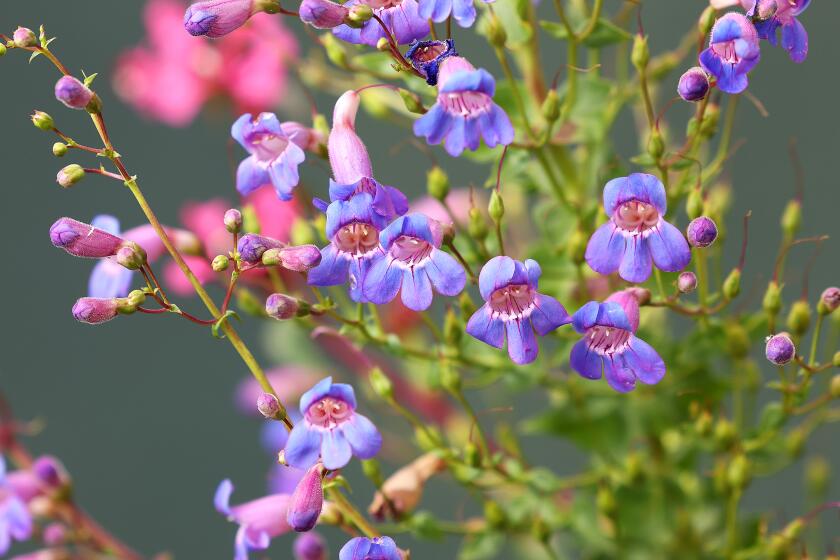Iniki Took Toll on Precious Plant Life of Hawaii Garden : Botany: Living laboratory of 6,000 rare and endangered species lost about 25% of collection to the hurricane.
- Share via
LAWAI, Hawaii — Several weeks ago, botanist Ken Wood rappelled a rugged Kauai cliff, hovering hundreds of feet above the surf to snip off a bit of one of the world’s rarest plants.
That fragile cutting of hibiscadelphus miraculously survived when Hurricane Iniki tore through the neatly groomed grounds of the National Tropical Botanical Garden on Sept. 11. But about a quarter of the garden’s collection of precious plants perished.
“It is like a Picasso or a Van Gogh,” said Marc Code, the garden’s acting director. “These are one-of-a-kind treasures that we are trying to save for mankind. Now we find ourselves trying to save them one more time--this time from nature.”
Chartered by Congress in 1964, the living laboratory boasts 6,000 species from around the world, including the largest native Hawaiian plant collection anywhere. Many plants are endangered, and some were thought to be extinct before botanical garden staffers found them on expeditions.
“We have collected these from all over the world for the last 20 years,” Code said. “We estimate that 75% of our collection is damaged and 25% was destroyed.”
At the 186-acre garden on Kauai’s south shore, tree trunks snapped in the storm, palms toppled and 140-m.p.h. winds stripped bushes of their leaves. Staffers are feverishly propping up plants, pruning broken trees and taking cuttings from specimens so badly wounded that they may die.
“It’s not a question of where do you start,” said Code, overseeing the plant rescue operation. “It’s when do you get finished.”
The storm slammed into the coconut-clad cove at the mouth of Lawai Valley, swallowing up a coral sand beach and pounding through the historic Queen Emma cottage and Allerton House. The buildings, part of the Allerton estate, had been used to house researchers visiting the National Tropical Botanical Garden.
The wind and waves blew out walls and furniture, pushing a wicker chair and painted wooden cabinet more than 100 yards into the valley. It then ripped through the botanical garden proper, tearing off part of the nursery’s roof and bursting open the picture windows of the director’s office.
“It looked like a snowstorm going by--all the official papers of the garden,” said librarian Richard Hanna, who holed up among the the bookshelves during the storm.
A week later, the garden still lacked electricity and running water, save for the stream that babbles through the property. Where dense foliage once painted a backdrop a hundred shades of green, there now are dead, brown branches sprinkled with salt spray piled high and no natural shade filters the sun.
Greg Nace, chief horticulturist, said the garden was vulnerable because it is an artificial environment, similar to a zoo or an aquarium. “We don’t have the same kind of buffer you have in the natural environment, where communities of plants form protective groupings,” he said. “A lot of ours are exposed and got ripped out of the ground.
“It’s just a heart-sickening feeling to see what you’ve worked so many years to build all of a sudden destroyed.”
The staff is grateful that the delicate seedlings in the nursery weathered the storm, along with most of the garden’s specimens. By contrast, Fairchild Tropical Garden in Miami reportedly lost as much as 70% of its collection in Hurricane Andrew.
“It could have been a whole lot worse,” said Douglas McBryde Kinney, chairman of the board of the Kauai garden. “I thought it was going to be absolute devastation, and it’s amazing how many trees are still standing. . . . Nature has selected out species that do pretty well in hurricanes was my conclusion.”
The nonprofit garden, which must rely totally on private donations despite its unique congressional charter, was seeking money, volunteers, generators and equipment to restore its irrigation system. But with much of the island in desperate shape, administrators feared that help might come too late.
“We asked for generators in Lihue (the county seat) and they laughed,” Code said. “They’ve got a list of 10,000 people who want generators.”
He said it was too early to estimate monetary damages to the garden and its buildings.
The most isolated island chain on Earth, Hawaii is a veritable showcase of evolution. More than 90% of its plant and animal life is found only in Hawaii. Although much of the native vegetation has been destroyed through human contact, Hawaii still offers a storehouse of wonders for scientists. Kauai, the oldest major Hawaiian island, is a vital link.
“The island is a time capsule of plants that have not yet been tapped for their possible role in the betterment of human life,” Code said. “And that’s why we save them. Even though you don’t know why this plant is needed and why that plant is here, sometime we may have the answer to that.
“All the pieces of the puzzle are important,” he said. “When you’re missing some of the pieces, you don’t have the complete balance in life.”





